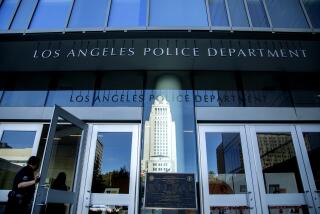From Despair to Action
- Share via
We’re just not going to take it anymore. That’s the message South and Southeast Los Angeles residents in particular and Angelenos overall are sending in the face of the first increase in serious crime here in several years. It’s a moving sign of just how far the community has come in battling back from the days of despair.
The city’s homicide count for the first six months of this year was 230, up 28% over the 1999 number, with most of the increase in South and Southeast. In response, protesters are marching and clergies have rallied their congregations. Community leaders and activists are demanding solutions. City Councilman Mark Ridley-Thomas, Assemblyman Antonio Villaraigosa (D-Los Angeles) and Los Angeles County Supervisor Yvonne Brathwaite Burke held community meetings that drew U.S. Atty. Alejandro Mayorkas, Los Angeles County Dist. Atty. Gil Garcetti, City Atty. James K. Hahn, school Supt. Roy Romer, Urban League President John Mack, Deputy Police Chief Martin Pomeroy and others.
For the record:
12:00 a.m. July 27, 2000 For the Record
Los Angeles Times Thursday July 27, 2000 Home Edition Part A Part A Page 3 Metro Desk 2 inches; 52 words Type of Material: Correction
Davis veto--A Times article July 11 and editorials July 13 and July 19 incorrectly stated the amount that Gov. Gray Davis vetoed from the state budget for a juvenile justice crime package. The correct amount is $121.3 million. The July 19 editorial also misidentified which California governor appointed Thomas J. Giaquinto to the Board of Prison Terms. It was Pete Wilson.
Of course, it’s an election year and the jockeying in next year’s mayor’s race and other key contests has already begun. The city is also gearing up for next month’s Democratic National Convention, and preparations for such big events tend to make residents in poorer areas feel even more neglected than usual. But that doesn’t explain this change. Now, it seems, lower crime rates have come to be expected rather than viewed as a forgiving blip on an otherwise rocketing crime rate chart.
Los Angeles police statistics showed that 525 people were murdered in the first six months of 1993. That was when several Los Angeles neighborhoods existed in resigned terror, giving up their streets at night, afraid to let children out to play even during daylight. You remember the stories. People were strafed in their homes by stray bullets. Some children even slept in bathtubs for protection. And those residents who dared to speak out publicly against crime were the ones looking over their shoulders, not the criminals.
Then came the decline. Experts were pressed to explain the welcome news that “only” 375 or so people were murdered during the first six months of 1994, 1995 and 1996. Scientists talked about “tipping points,” subtle changes that can spark dramatic declines or increases. In 1999, the nation’s longest-running drop in serious crime since at least 1960 reached eight years.
Now, amid indications that the declines may have come to an end, Gov. Gray Davis is rightly and roundly criticized for his line-item veto of $71 million for juvenile crime prevention programs. Los Angeles County’s Juvenile Justice Coordinating Council would have received $34 million of that. The City Council wants Police Chief Bernard C. Parks to explain how he will attack this spike in serious crime. Mayor Richard Riordan’s office says that he will announce a strategy perhaps this week.
The people of Los Angeles are saying that they won’t go back without a fight to the days of high crime rates. City and regional leaders are scrambling to respond. That’s how it ought to work when a city no longer accepts living in fear.
More to Read
Sign up for Essential California
The most important California stories and recommendations in your inbox every morning.
You may occasionally receive promotional content from the Los Angeles Times.










